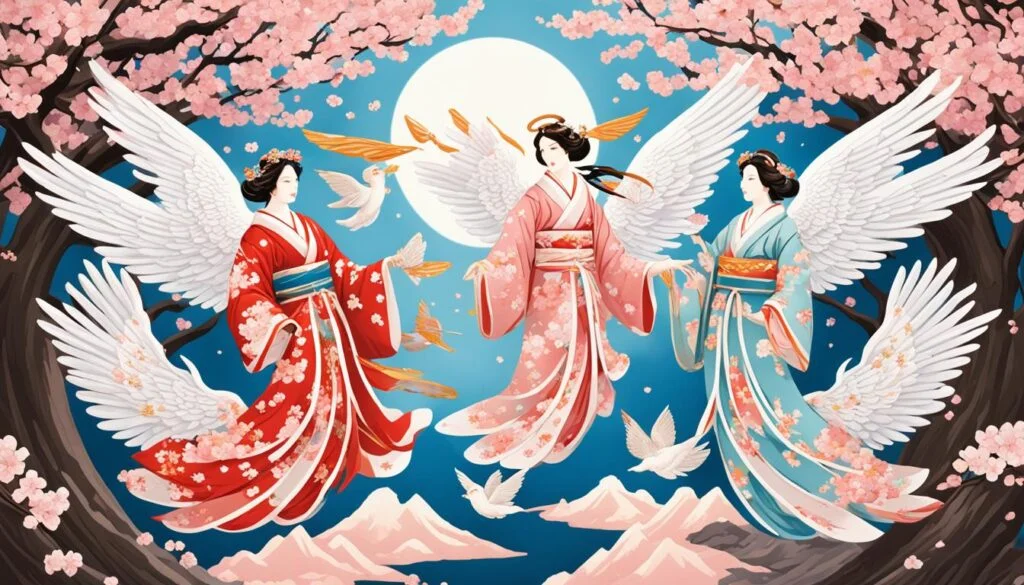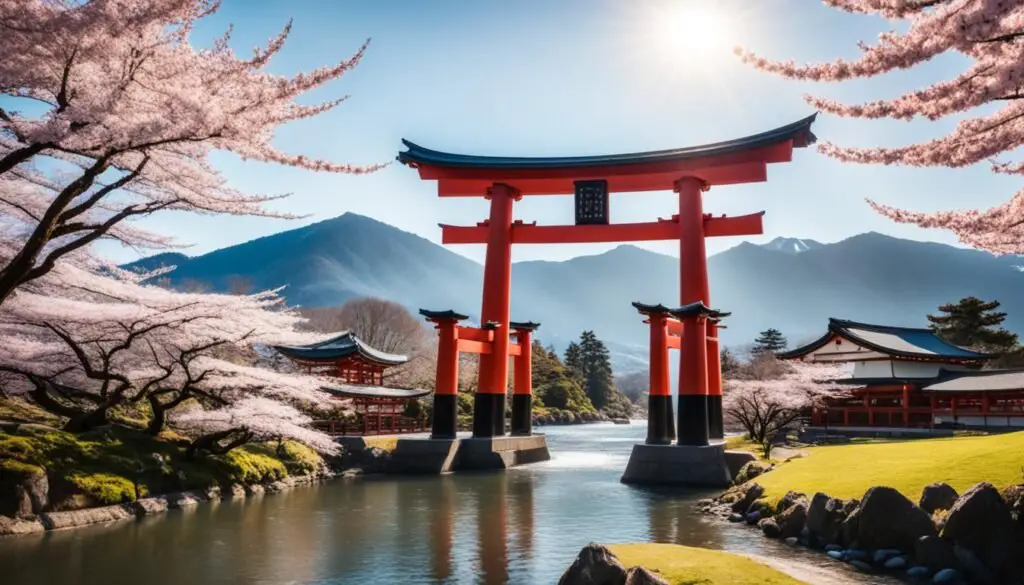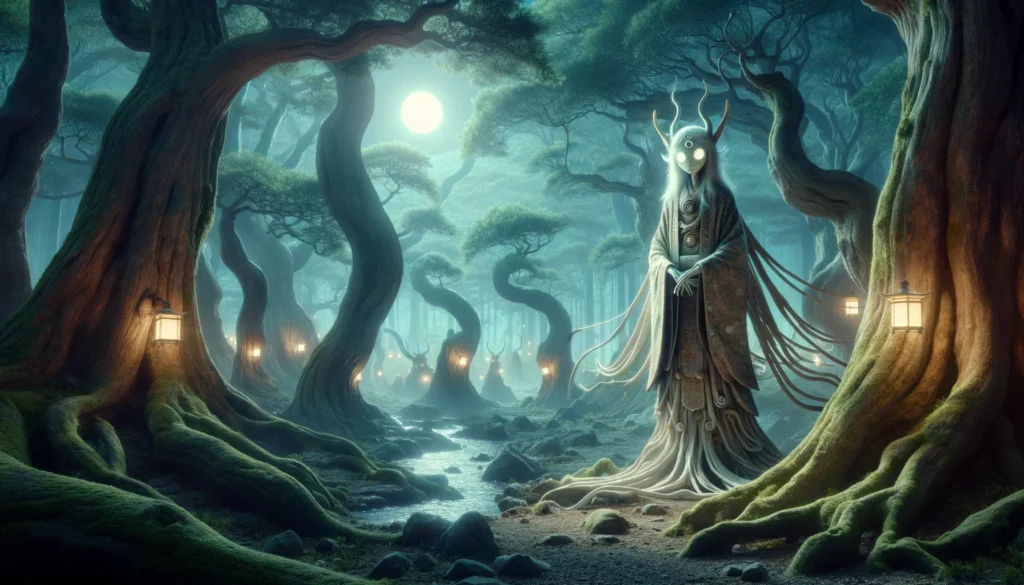Welcome to our fascinating journey into the mythological world of Japan! In this article, we will delve into the rich tapestry of Japanese folklore and explore the existence of angels within it.
Japan holds a unique place in the realm of mythology, with its vibrant and diverse collection of celestial beings and supernatural entities.
Japanese mythology does not have “angels” in the way Western cultures understand them, but it features kami and other benevolent spirits that serve similar functions. These entities, found within Shinto and Buddhism, offer guidance, protection, and support, acting as guardians or helpers to humans.
We’ll uncover the tales, legends, and ancient texts that depict these celestial beings, unveiling their significance in Japanese folklore and spirituality.
Key Takeaways:
- Angels have a prominent presence in Japanese mythology, showcasing the rich cultural tapestry of the nation.
- Japanese folklore portrays angels as celestial beings with various forms and roles.
- Exploring the existence of angels in Japanese mythology offers insights into the country’s belief systems and spirituality.
- Japanese folktales and legends often feature angelic figures as divine protectors and sources of guidance.
- The presence of angels in Japanese mythology reflects the universal fascination and belief in celestial beings across different cultures.
What is the Concept of Angelic Beings in Global Mythologies?
In our exploration of angelic beings, it is important to broaden our perspective and examine their presence in various mythologies worldwide.
From the celestial messengers in Western traditions to the diverse range of celestial beings found in different mythological systems, the concept of angelic beings has captivated cultures across the globe.
Angels in Western Traditions
In Western traditions, angels are often portrayed as divine beings with ethereal wings, serving as intermediaries between the earthly and spiritual realms.
They are seen as messengers of God, providing guidance, protection, and carrying out important tasks.
From the archangels such as Michael and Gabriel to the choir of angels, Western mythologies offer rich narratives surrounding these celestial beings.
Comparative Overview of Celestial Beings in World Mythologies
However, the concept of celestial beings goes beyond Western traditions. In other mythologies, we find a diverse range of angelic figures that share similar qualities, yet possess unique characteristics and roles.
For example, Hinduism acknowledges various divine beings, such as the devas and apsaras, who play significant roles in shaping the universe and guiding mortals.
In Chinese folklore, the concept of celestial beings takes the form of deities like the Eight Immortals, revered for their supernatural powers and benevolent guidance.
To gain a deeper understanding of these celestial beings, we will analyze different cultural perspectives, examining how different mythologies depict and interpret their roles.
By comparing these figures, we can gain insights into the universality of divine messengers and their significance in shaping cultural beliefs and practices.
With this comparative exploration, we aim to shed light on the diverse interpretations and significance of angelic beings across mythological systems.
By delving into these global mythologies, we can unveil the cultural and spiritual significance bestowed upon these celestial entities.
What are the Angelic Entities in Shinto Religion?
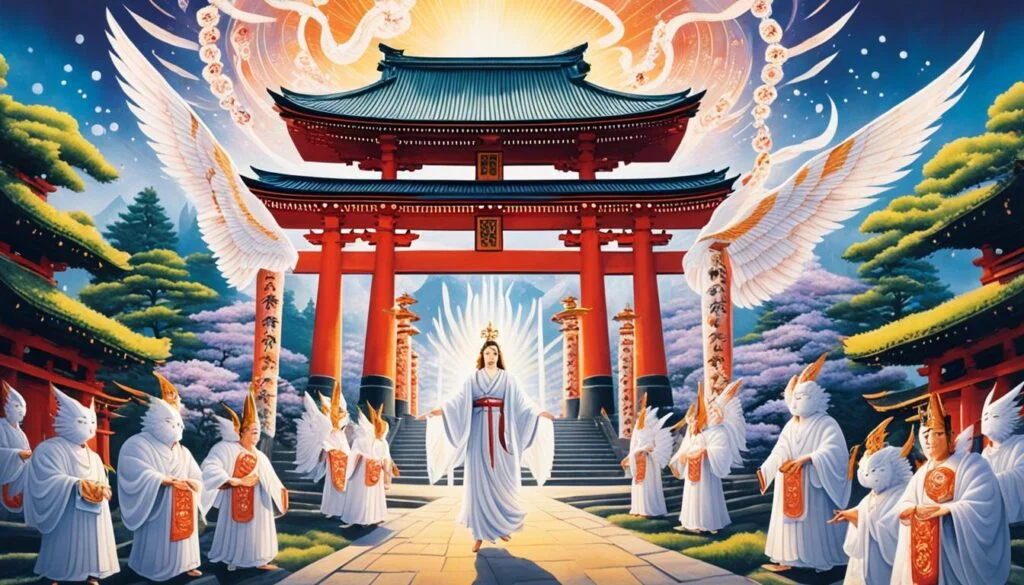
Shinto, the indigenous religion of Japan, holds a significant place in Japanese culture and spirituality.
Within the Shinto belief system, there exist angelic entities known as kami, the divine spirits of Shinto.
These kami are revered and worshipped as supernatural beings embodying various aspects of nature and human life.
Kami – The Divine Spirits of Shinto
The concept of kami in Shinto is deeply rooted in the belief that nature and the spiritual realm are interconnected.
Kami are seen as powerful entities that can influence both the physical and spiritual aspects of life.
They are considered embodiments of sacredness and are believed to reside in natural objects, such as mountains, rivers, trees, and even animals.
Kami are not transcendent deities but are immanent within the natural world. They are viewed as teachers and guardians, guiding humans toward a harmonious existence with nature and promoting virtuous conduct.
The worship of kami is central to Shinto practices, with numerous shrines dedicated to specific kami throughout Japan.
Notable Kami with Angelic Roles
While the concept of angels in the Western sense may not directly translate into Shinto beliefs, there are certain kami that are often associated with angelic roles within Japanese mythology.
One well-known kami associated with angelic qualities is Amaterasu, the sun goddess.
Amaterasu is considered the ancestor of the Japanese imperial family and is revered as a benevolent and powerful deity.
She is often depicted as a radiant figure embodying the light and warmth of the sun, symbolizing enlightenment and divine protection.
Another notable kami is Hachiman, the god of war and the patron deity of warriors. Hachiman is believed to protect the nation and its people, offering guidance and assistance during times of conflict and peril.
His association with divine protection and martial prowess aligns with the qualities commonly associated with angelic beings.
These are just a few examples of the angelic roles that kami play within Shinto mythology.
The diversity of kami and their associated attributes highlight the complex and multifaceted nature of angelic entities in Shinto religion.
What are the Celestial Beings in Japanese Buddhism?
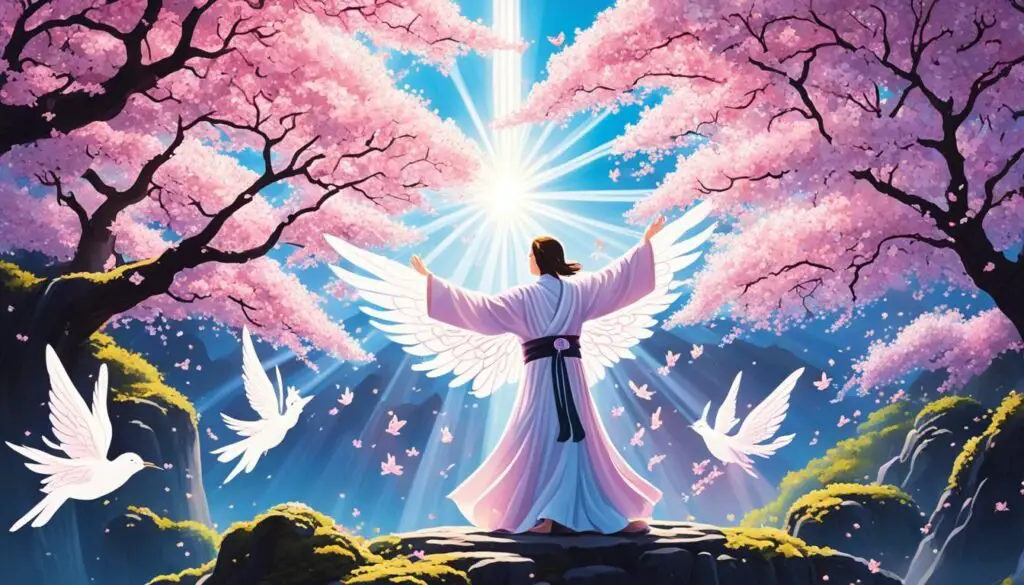
In Japanese Buddhism, the belief in celestial beings plays a significant role. These celestial beings are known as bodhisattvas, compassionate protectors who guide and assist individuals on their spiritual journeys.
Bodhisattvas are revered figures in Japanese Buddhism, representing the embodiment of compassion and wisdom.
Bodhisattvas – Compassionate Protectors
Bodhisattvas are enlightened beings who have chosen to delay their own enlightenment in order to help others attain awakening.
They are seen as compassionate protectors who have the ability to intercede on behalf of individuals and offer guidance and support.
The bodhisattva ideal is central to Mahayana Buddhism, including Japanese Buddhism.
Bodhisattvas are seen as exemplifying the ideals of selflessness, compassion, and the aspiration to alleviate the suffering of all beings.
They are revered and revered as spiritual mentors and sources of inspiration.
Specific Bodhisattvas and Their Significance
Japanese Buddhism recognizes various bodhisattvas, each with their own specific qualities and roles.
Among the most well-known bodhisattvas in Japanese Buddhism are:
- Kannon Bodhisattva: Known as the “Goddess of Mercy,” Kannon is often depicted with multiple arms and eyes, symbolizing her ability to perceive and respond to the suffering of all beings.
. - Jizo Bodhisattva: Jizo is considered the protector of children and travelers, providing support and guidance in times of difficulty. Jizo is often depicted as a monk-like figure with a staff and a vow to help those in need.
. - Maitreya Bodhisattva: Maitreya is regarded as the future Buddha who will appear in a future age to bring enlightenment to all beings. Maitreya represents hope and the promise of a better future.
These bodhisattvas, along with many others, hold significant importance in Japanese Buddhism.
They are revered as sources of inspiration, compassion, and guidance, providing devotees with a sense of hope and support on their spiritual paths.
What are the Folklore and Mythological Tales Featuring Angel-Like Beings?
Throughout history, folklore and mythological tales have featured angel-like beings in various cultures.
These celestial entities, often depicted as divine messengers or protectors, captivate the imagination and inspire wonder.
In the context of Japanese mythology, there are numerous stories that showcase the presence of angelic or angel-like beings.
Tales of Heavenly Assistance
One such tale is the story of Urashima Taro, a legendary fisherman who rescues a turtle from torment.
In gratitude, the turtle guides him to the underwater palace of the Dragon King. There, Urashima Taro meets the beautiful princess Otohime, whom he falls in love with.
After spending what felt like a few days in the palace, he decides to return to the surface world. However, upon his return, he realizes that centuries have passed, and everything he once knew has changed.
This tale, often interpreted as a metaphor for the temporal nature of life and the interplay between humans and divine beings, showcases the celestial aid provided by angel-like creatures in Japanese folklore.
Another famous tale is Momotaro, the story of a boy born from a peach who embarks on a journey to defeat demons alongside his animal companions.
Throughout his quest, Momotaro encounters supernatural beings, including a dog, a monkey, and a pheasant, who assist him in his battles against evil.
These animal allies, with their otherworldly powers and unwavering loyalty, can be seen as representations of angelic beings, providing heavenly aid to those in need.
Interpretations of Celestial Aid
In Japanese folklore, the concept of celestial aid goes beyond physical assistance and extends to moral and spiritual guidance.
Angels or angel-like beings in these mythological tales often serve as guiding lights, offering wisdom and support to protagonists.
They represent the embodiment of virtue and are revered for their purity and benevolence.
Moreover, interpretations of angelic assistance in Japanese folklore vary, reflecting the multifaceted nature of these celestial beings.
Some stories portray angels as intermediaries between humanity and higher realms, bridging the gap between mortal and divine.
They act as messengers, delivering divine messages and revelations to individuals, guiding them on their paths.
Other tales highlight the transformative power of angel-like beings, emphasizing their role in helping individuals overcome challenges and achieve personal growth.
These stories often contain a moral lesson, teaching readers about resilience, compassion, and the importance of cultivating virtues in their own lives.
In conclusion, the folklore and mythological tales of Japan are replete with angel-like beings, providing heavenly assistance and guiding protagonists on their journeys.
These tales not only captivate our imagination but also offer insights into the cultural and spiritual significance of celestial beings in Japanese folklore.
What is the Cultural Significance of Angelic Beings in Japan?
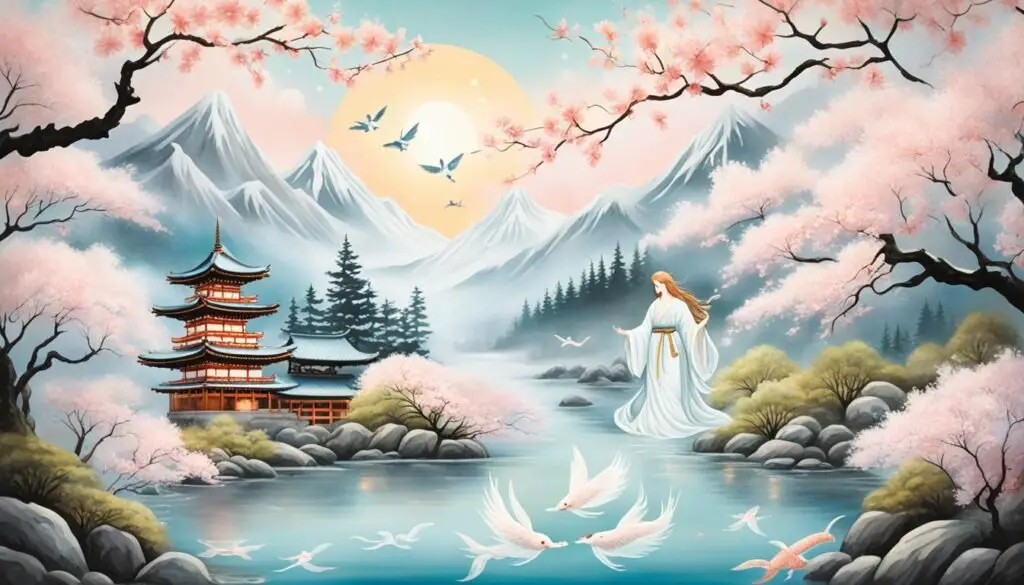
Angelic beings play a significant role in Japanese culture beyond their presence in mythology.
These celestial figures hold immense cultural significance and are deeply embedded in Japanese spirituality.
Let us explore their role and influence on various aspects of Japanese culture.
The Role of Angelic Figures in Japanese Spirituality
In Japanese spirituality, angelic figures serve as intermediaries between humans and the divine realm. They are seen as messengers of blessings, protection, and guidance.
These celestial beings are believed to possess profound wisdom, compassion, and purity, embodying ideals that humans aspire to attain.
Through their connection to the divine, angelic figures contribute to the spiritual development and enlightenment of individuals.
Moreover, angelic figures are often depicted as guardians and protectors, watching over individuals, families, communities, and even the nation as a whole.
Japanese people turn to these angelic beings for inspiration, solace, and strength in times of adversity, seeking their benevolent presence and guidance.
Angels in Contemporary Japanese Culture
The cultural significance of angelic beings extends beyond the realms of spirituality and mythology in Japan.
These celestial figures have permeated various aspects of contemporary Japanese culture, leaving their mark on art, literature, and popular culture.
Japanese art showcases the ethereal beauty and elegance of angelic figures through intricate paintings, sculptures, and visual representations.
These artworks depict angels in various forms, capturing their celestial grace and divine qualities.
Literature also reflects the influence of angelic beings in Japanese culture. Numerous works of Japanese literature incorporate angel-like characters that symbolize purity, guidance, and divine intervention.
These characters often serve as catalysts for spiritual growth and personal transformation.
In popular culture, angelic figures feature prominently in anime, manga, and video games, captivating audiences with their otherworldly allure and mystical powers.
They are portrayed as heroic, enigmatic, and awe-inspiring characters, reflecting the enduring fascination with angelic beings among the Japanese people.
Understanding the Differences and Similarities
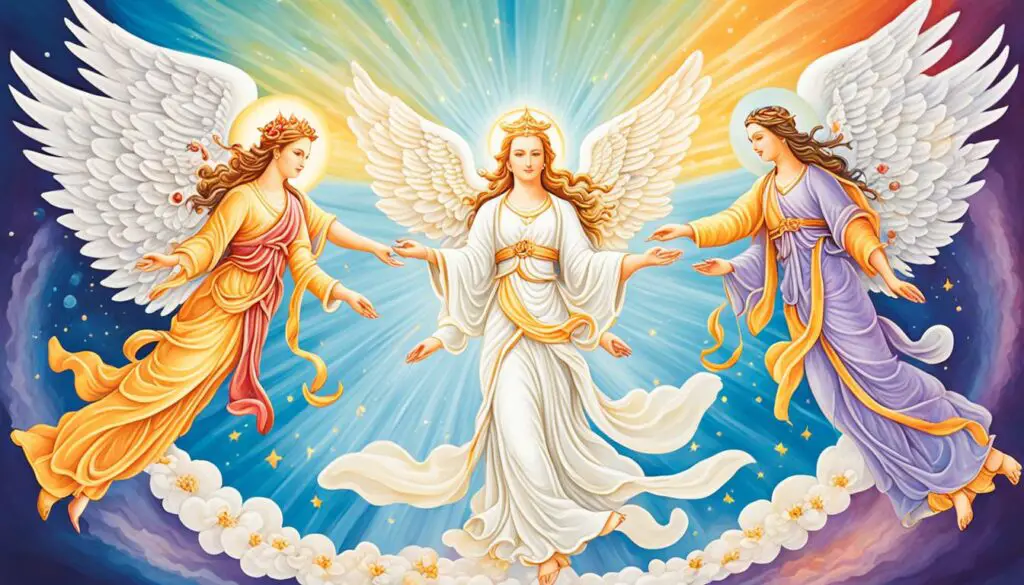
In this section, we will compare and contrast angels, kami, and bodhisattvas to gain a deeper understanding of these divine beings.
We will analyze the differences and similarities between these entities, exploring their roles as divine messengers and protectors in their respective mythologies.
By doing so, we will highlight the universality of these celestial entities in various religious and cultural traditions.
Angels vs. Kami and Bodhisattvas
Angels, kami, and bodhisattvas hold significant roles in their respective mythologies.
Although the context and beliefs surrounding these divine beings may differ, there are notable differences and intriguing similarities among them.
Differences:
- Angels: In Western traditions, angels are often depicted as heavenly beings tasked with carrying out divine messages and protecting humans. They are known for their ethereal beauty and are believed to serve a higher power.
. - Kami: In Shinto, kami are revered as divine spirits that reside in natural elements, objects, and ancestors. They are seen as the essence of the sacred and embody the awe-inspiring forces of nature. While some kami may act as intermediaries between humans and the divine, they are not typically associated with protective roles.
. - Bodhisattvas: In Buddhism, bodhisattvas are compassionate beings who vow to attain enlightenment to help others. They are regarded as enlightened and selfless individuals who postpone their own liberation to assist others on their spiritual journey. Bodhisattvas are often seen as compassionate guides and protectors.
Similarities:
- Divine Messengers: Angels, kami, and bodhisattvas all share the role of divine messengers. They act as intermediaries between the divine realm and humans, delivering messages, guidance, and inspiration.
. - Protectors: While the nature of their protective roles may vary, angels, kami, and bodhisattvas are commonly associated with safeguarding and assisting individuals in different ways. Whether through divine intervention, offering solace, or guiding spiritual growth, these celestial beings serve as protectors.
The Universality of Divine Messengers and Protectors
Across different mythologies and religious traditions, the presence of divine messengers and protectors is a universal concept.
Angels, kami, and bodhisattvas exemplify the human desire for guidance, support, and divine connection.
While their forms and cultural interpretations may differ, the fundamental role they play in spirituality and mythology highlights the intrinsic human need for celestial assistance.
Conclusion
Throughout our exploration of Japanese mythology, we have delved into the existence of angels and angelic beings in this rich folklore tradition.
From Shinto to Buddhism, angelic entities have played significant roles in Japanese spirituality and culture.
These celestial beings, known as kami and bodhisattvas, embody compassion, protection, and divine assistance.
In Japanese folklore and mythological tales, we have discovered numerous stories that feature angel-like beings providing heavenly aid to humans.
These tales offer different interpretations of celestial assistance, highlighting the universality of the concept of divine messengers and protectors across cultures.
The cultural significance of angelic beings in Japan extends beyond their role in mythology.
They have influenced art, literature, and popular culture, showcasing their enduring presence in Japanese society.
Angelic figures continue to inspire and captivate people, symbolizing hope, guidance, and spiritual connections.
In conclusion, angels in Japanese mythology represent a profound part of the country’s folklore and cultural heritage.
They embody the belief in benevolent celestial beings and the power they possess to guide and protect.
By exploring the existence of angels in Japanese mythology, we gain a deeper understanding of the spiritual beliefs and values that shape Japan’s rich cultural tapestry.
FAQ
What is the concept of angelic beings in global mythologies?
Angelic beings are celestial entities that appear in various mythological systems around the world. They are often portrayed as divine messengers, intermediaries between the human and divine realms.
What are angels in Western traditions?
In Western traditions, angels are spiritual beings that serve as messengers of God. They are typically depicted as benevolent beings with wings and are believed to have a direct connection to the divine.
How do celestial beings in different mythologies compare?
Celestial beings in different mythologies share certain similarities, such as their role as messengers and protectors. However, their appearance and specific attributes may vary depending on the cultural context.
What are the angelic entities in Shinto religion?
In Shinto, angelic entities are known as kami, which are divine spirits present in nature and various aspects of Japanese culture. They are revered as guardians and protectors.
Who are some notable kami with angelic roles?
Some notable kami with angelic roles in Japanese mythology include Amaterasu, the sun goddess, and Hachiman, the deity of war and divination.
What are the celestial beings in Japanese Buddhism?
In Japanese Buddhism, celestial beings are known as bodhisattvas. These compassionate protectors guide individuals on their spiritual paths and are revered for their wisdom and enlightenment.
Which specific bodhisattvas are significant in Japanese mythology?
Some specific bodhisattvas that hold significance in Japanese mythology include Kannon, the bodhisattva of compassion, and Jizo, the bodhisattva of the afterlife and protector of children.
Are there folklore and mythological tales featuring angel-like beings in Japan?
Yes, there are folklore and mythological tales in Japan that involve angelic or angel-like beings. These stories often depict heavenly assistance and vary in their interpretations of celestial aid.
What is the cultural significance of angelic beings in Japan?
Angelic beings have a significant cultural impact in Japan. They play a role in Japanese spirituality and have influenced various aspects of Japanese culture, including art, literature, and popular culture.
How do angels, kami, and bodhisattvas differ and relate to each other?
Angels, kami, and bodhisattvas are all divine beings, but they originate from different mythological and religious traditions. While there may be similarities in their roles as messengers and protectors, their specific attributes and cultural contexts differ.
What is the conclusion of the exploration of angels in Japanese mythology?
The exploration of angels in Japanese mythology reveals their presence in various belief systems and their significant role in Japanese folklore and culture. Angelic beings serve as messengers, protectors, and sources of inspiration in Japanese mythological traditions.


